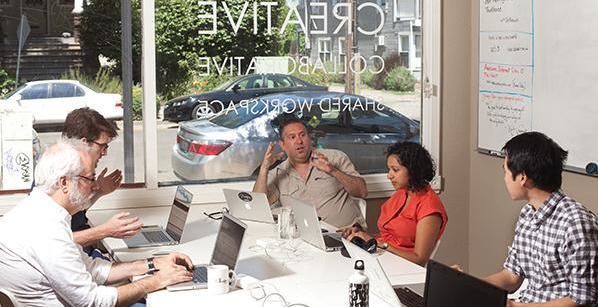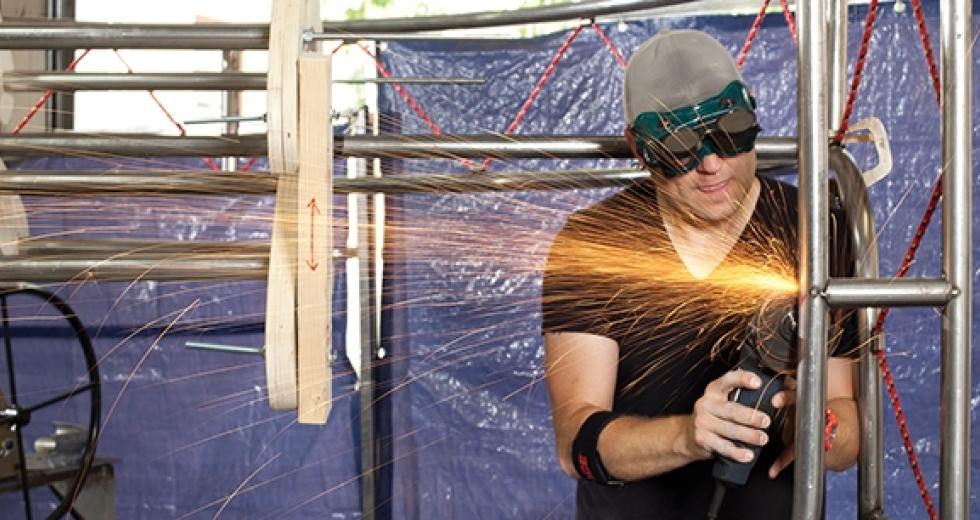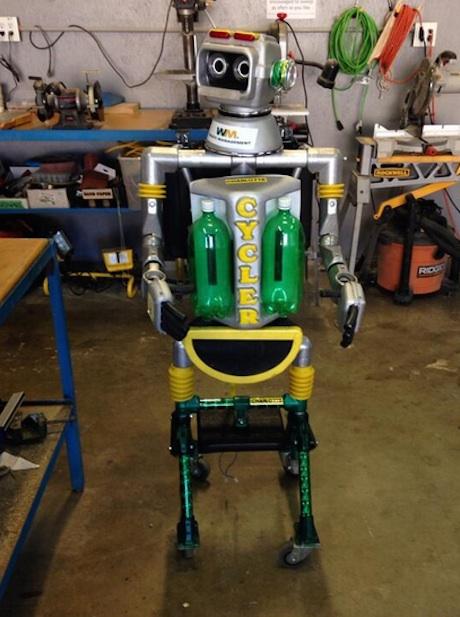Casey Marshall is hunched over his phone, furiously scrolling through his Twitter feed in search of a photo of Waste Management’s promotional robot, whose broken axle he fixed back in March. “Someone came into the Hacker Lab and needed his robot repaired,” he says, grinning, “and I was like, ‘I gotta do that.’”
Marshall is part of a growing sect of workers without a home — tinkerers, thinkers, developers, designers and storytellers who are shunning the ever-elusive gold watches and hefty retirement packages of corporate employment and riding the wave of the recession from cubicles to coworking spaces and coffee shops.
Far from being pushed out by a flailing economy and corporate cost cutting, Marshall chose to leave his lucrative position at a local architecture firm, in search of a more fulfilling career on his own. At work, he says he felt himself spinning his wheels, watching projects float away only to come back at the 11th hour in need of serious fixing. He is a man obsessed with products and processes, and the inefficiency of office politics left him frustrated.
Having rolled the dice as a freelance worker back in 2001, when he was both a student and soon-to-be father (“I needed to finish school, but I also needed to put Pampers on my guy,” he now says of the decision), Marshall felt that, with a degree and years of experience under his belt, he could create a viable career for himself.
“That first freelance stint is when I learned what I’m good at. I like to build stuff and make things, but I thought I should do the architecture thing because that would really satisfy and satiate me,” he laughs. “Well, I did that and then some. And it didn’t.”
So on March 7, he turned in his briefcase for a messenger bag. Since then, he says he has been able to cobble together enough of the kind of work that he loves — creative work that uses his architectural and design background to develop customized functional art. In addition to the robot fix, he created design infrastructure to make a conference room look like a Star Trek-esque medical bay and is now working on a rolling media center, the “Monitaur,” that will support a flat screen monitor to be raised and lowered with a giant slot-machine handle. Both of the projects have been for VSP, which he says “really helped me make the leap into independence land.”
“I’m working with my hands, thinking with my hands, coming home and having my son go, ‘You made that today? That’s awesome!’” Marshall says. “Before that, I would have to be like, ‘Well, I drew 432 lines at right angles to each other, but some of them were wrong and I had to fix them.’ It’s different.”
Finding and Defining
Workers like Marshall aren’t searching for full-time jobs or benefits packages. They are willingly, nay willfully, forging their own ways. And while not every independent worker stands on solid footing, they take the risk in search of greater control over both their days and their destinies.
But they are a difficult group to define and track. A 2010 study by Intuit predicts 60 million freelancers by 2020, or 60 percent of the workforce. A 2006 study by the U.S. Government Accountability Office put the number at 42 million, or one-third of the workforce. This is the figure used by the Freelancers Union, and it has been regurgitated everywhere from Quartz to Forbes to The Guardian. But the statistic is problematically broad: It includes everyone from an independent graphic designer to your local bartender (which, admittedly, could be the same person).
On the more conservative side is a 2005 study by the Bureau of Labor Statistics that estimates anywhere from 2 to 7 percent of the workforce to be independent. A 2013 study by MBO Partners, which provides financial guidance and resources to independent workers, estimates 17.7 million, or 8 percent, of employed individuals work independently, and it projects that number will rise to 30 million by 2020.
Many of these workers call California home.
“California has always been a relatively high state for self-employment and independent workers,” says Steve King of consulting firm Emergent Research, who worked on the MBO study. “It’s always been in the top 10 states in terms of the self-employed.” King says this is driven by both lifestyle expectations as well as tech, agriculture and mobile gaming industries.
Part of the difficulty in tracking independent workers is defining the subjects. Marshall, who runs a company of one called Fabritype, calls himself a business owner. Less than 4 percent of MBO’s respondents self-identified as freelancers (most of them leaned toward “self-employed” or “independent contractor”).
Janna Maron, who started ThinkHouse Collective in 2010, says part of the struggle of self-definition resides in legitimacy and outside perceptions.
In addition to founding and running ThinkHouse with her husband, Maron teaches as an adjunct professor at Sacramento City College and William Jessup University, publishes a quarterly literary magazine called Under the Gum Tree and still finds time to write her own work and edit outside projects on the side. But don’t call her self-employed.
“There’s this perception that self-anything isn’t legitimate,” she says from a quiet corner in ThinkHouse. The space is far more subdued than Hacker Lab. There’s no banging of tools echoing from unseen recesses, and it’s filled with little nooks perfect for deep concentration. “So I was like, ‘Screw that, I’m not going to be a self-publisher. I’m going to be an indie publisher.’ And I definitely chose that word because of the perception.”
Left to RIght: Rich Webster, Harrison Reich, Jeremy Maron, Monica
Bhatt & David Sudarma work from Thinkhouse Collective

But that perception shows signs of change, and it looks like America’s collective headspace might soon abandon the notion of freelancers as out-of-work scamps peddling services for chump change. According to MBO, 32 percent of America’s traditional employees have worked independently at some point in their careers, a figure that is expected to jump to more than 40 percent by 2018.
“A decade ago, contract workers were used for low-paying and
low-skill positions,” says King. Compare that to today, where
King says that often high-skill talent is hired on a
contract basis.
The logic is that the more workers who have worked independently, the more there are who understand independent work as a viable career option. But a little over half of traditional employees surveyed by MBO still site security and lack of benefits as a drawback of independent work.
“I don’t think a standard 9-to-5 job is really secure,” points out Maron. “During the recession, people were losing their jobs, and after they were laid off, they couldn’t find a new job. So now instead of getting a new job, people are creating their own jobs or creating work for themselves, essentially.”
The Impact
Independent workers may even drive job creation. Many start off as “solopreneurs,” and MBO reports that in 2013 independents spent $96 billion hiring the equivalent of 2.3 million full-time workers.
They also allow small businesses to remain agile as they grow and compete in an ever-expanding marketplace. Tina Reynolds, owner of Sacramento communications and design firm Uptown Studios, says freelancers have been essential to her business’ expansion. When the workload gets too big for her team to manage in-house, she can bring in a freelancer to help shoulder some of the burden and then build that cost into client contracts. This helps with the transition from overflow to growth and may eventually lead to a new employee.
“If we are steadily utilizing [a freelancer] for approximately 40 to 60 percent of what a new employee would cost, we begin discussing bringing a new person onto the team,” she says.
Reynolds says Uptown Studios is not only increasing its number of freelancers in all areas, it has also hired five new employees since 2010. So an increase in contract workers doesn’t mean the end of salaried employees.
“It’s challenging to get the depth of each project to (freelancers) in a way where they understand the client needs as well as someone working internally,” says Reynolds. “We still try to keep as much as possible in-house.”
Gene Zaino, president and CEO of MBO Partners, agrees. “Full-time employees are your core. They have the culture of your company, they understand the institutional dynamics of your company and they are tied to the mission. But you can structure your company in a way that it can engage the kinds of resources that independent workers provide. It gives the company a lot of agility to be able to adapt to its market.”
However, a strong independent working class and an increased emphasis on a balanced lifestyle over the 9-to-5 workday may have trickle-down benefits for traditional full-time employees.
Telecommuting, which more often than not leads to that flexibility and freedom so touted by independent workers, is on the rise. An annual survey by the Society for Human Resource Management found that almost 60 percent of organizations offered flex time and the option to telecommute at least part-time. “If you can do your job in four hours a day and do it well, I don’t really care what you do with the rest of your workday,” says Gina Lujan, co-founder of Hacker Lab and independent worker/small-business owner since 2000. “I think we should treat our employees like they are adults, and if they aren’t getting the job done then they’re not the right employee.”
An evolving structure of full-time employment coupled with a lack of resources for independent workers means traditional employment isn’t going away anytime soon.
It Ain’t Easy on Your Own
On top of the next gig, independent workers worry about bookkeeping, health care, business and marketing expenses, and a 15.3 percent self-employment tax (don’t worry, that drops to just under 3 percent once you make your first cool $113,700). Zaino recommends that, all factors accounted for, independent workers ought to charge 50 percent more than the salaried rate for the same job.
“There needs to be more business services available for freelancers and the startup community,” says Lujan, who recently launched HackerCare to provide health insurance to startups and employees of the tech industry. “I think the small-business associations and these other traditional business associations have catered to the brick-and-mortar businesses. The startup and freelance communities have been a driving force for the last 10 years, so I’m sort of waiting for the resources to catch up to that trend.”
While online support services like Elance, LinkedIn and even
Craigslist might streamline the process for independent workers
seeking jobs, and while companies like Airbnb and
Zipcar make it easier to take one-off jobs away from home, Zaino
says there is still a gap in this market waiting to be filled.
“I believe you’re going to see, and it’s happening already, an entirely new industry built around supporting freelancers,” Zaino says. “They need everything from education on how to run a business to billing and collections and knowing how to find the next project. There are companies out there evolving, and I believe you’re going to see a big trend in a new industry that supports the person who wants to work on their own.”
The Bottom Line
Are independent workers really taking over the workforce and ousting the 9-to-5 job from its throne? Or are they just a smattering of idealists, a lucky few managing to make the unworkable work?
The answer probably lies somewhere in the middle. But the numbers are indeed growing and, according to Zaino, “This is not cyclical, it’s structural. It’s not going away if the economy bounces back.”
Those finding a way to make it work intend to stay the course. The MBO sites job satisfaction for independent workers at more than 70 percent. The study makes a distinction between “job makers” (think freelance web developer) and “task takers” (think data entry temp worker), and when looking solely at the job makers, that satisfaction rate jumps to over 85 percent. Fewer than 4 percent of job makers see themselves returning to traditional employment.
Maron laughs when asked if she’d ever go back to traditional work. “I don’t think I would make a good employee,” she says. “Beyond that, the independent lifestyle is just so flexible and so empowering for someone like me.”
Marshall has just finished creating a logo and business cards for Fabritype. He says that, looking forward, his long term goal is to spend 80 percent of his time creating his own products and 20 percent as a contractor helping clients create things and fine-tune processes.
“I’m so satisfied,” he says, flipping his new business card around on the table. “I’m playing all day, in a way.”
Recommended For You
Hunting the Elusive Benefit Package
The endangered benefit plans nears extinction
While much of the local and national talk around pension reform is directed at public employees, the biggest current changes are occurring in the private sector.

Brain Drain
How can Sacramento keep its millennials in the mix?
About a decade ago, as a financial analyst for Intel, I lived in the suburbs of Santa Clara and frequently traveled to Folsom. It was a good job, especially for a kid straight out of college — decent pay, strong company and the lure of glittering stock options.
So I left.

Think Anywhere
Is telecommuting the the wave of workforce future?
Pilot and Arba see those offices and the traditional 8-hour workday as inefficient and outdated relics of the industrial age, when a set shift and common location were vital for communicating and performing work.





